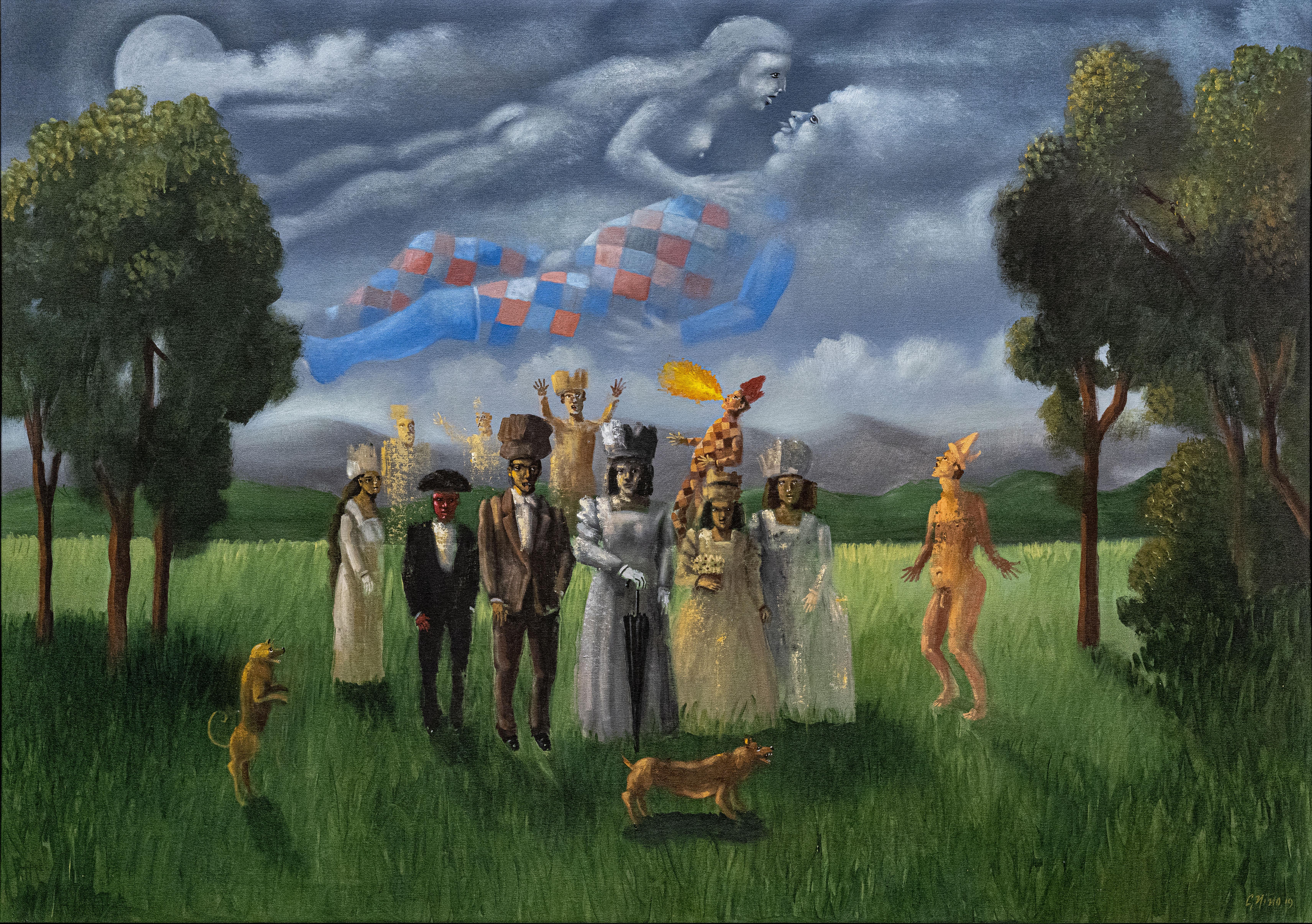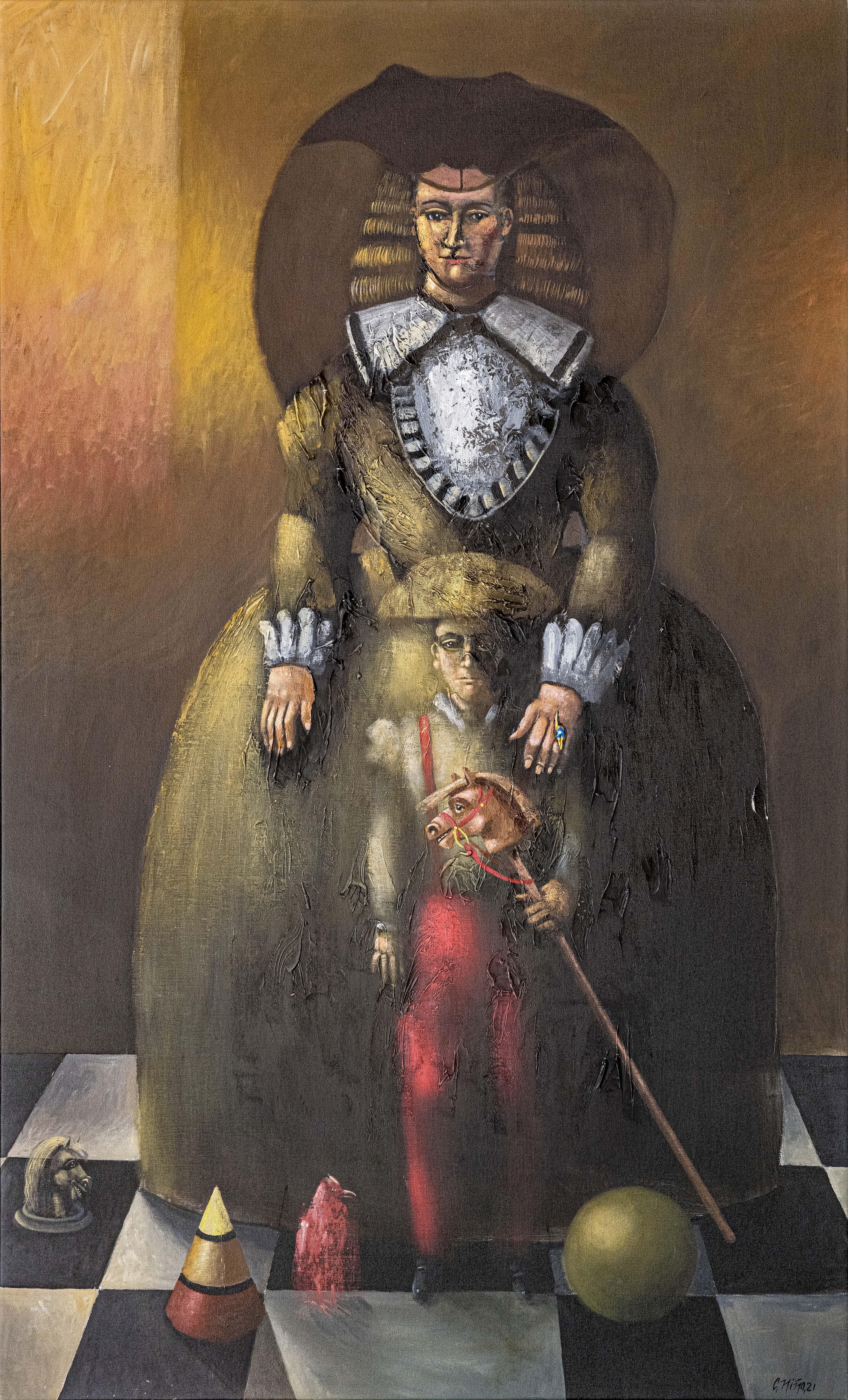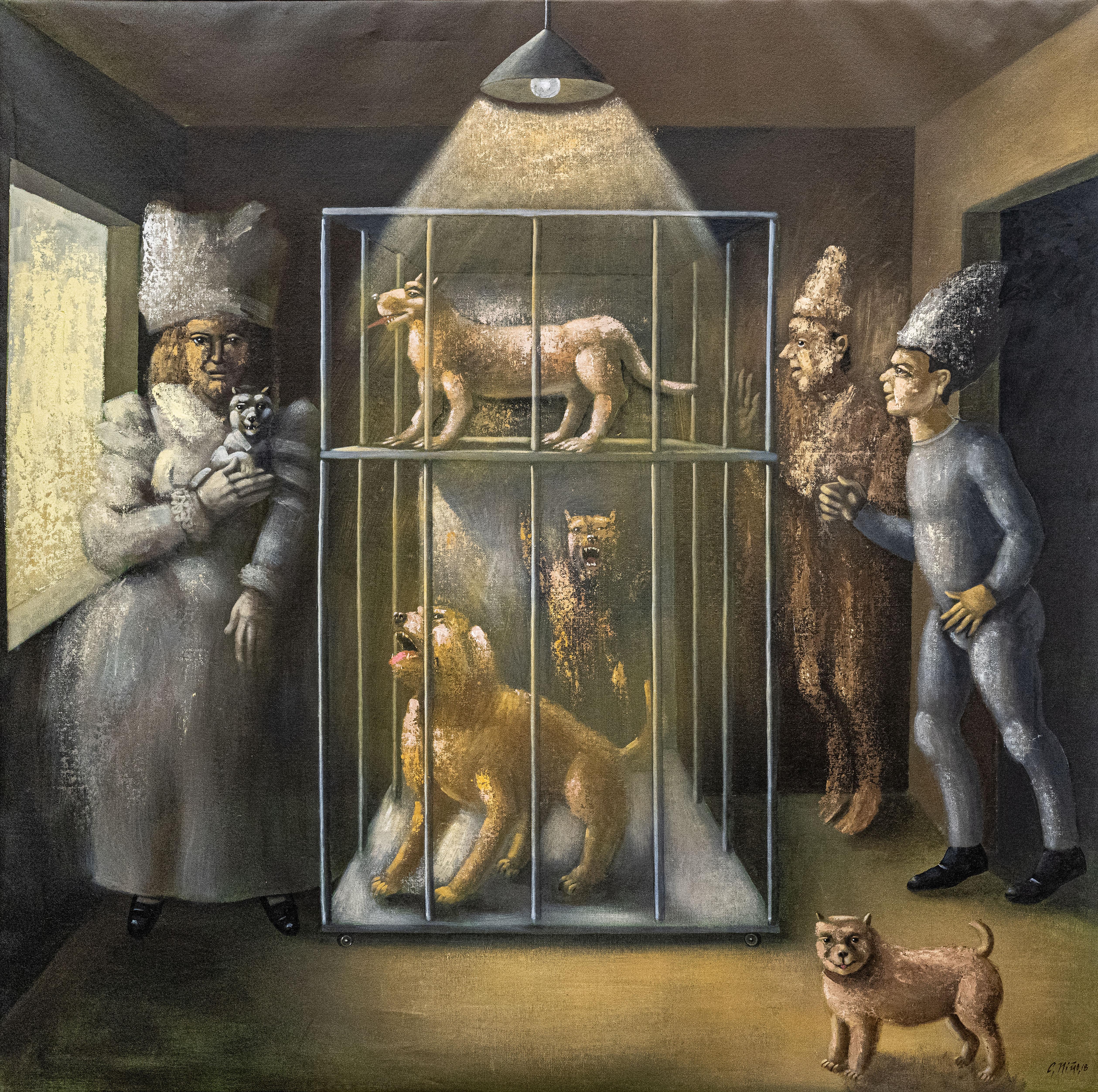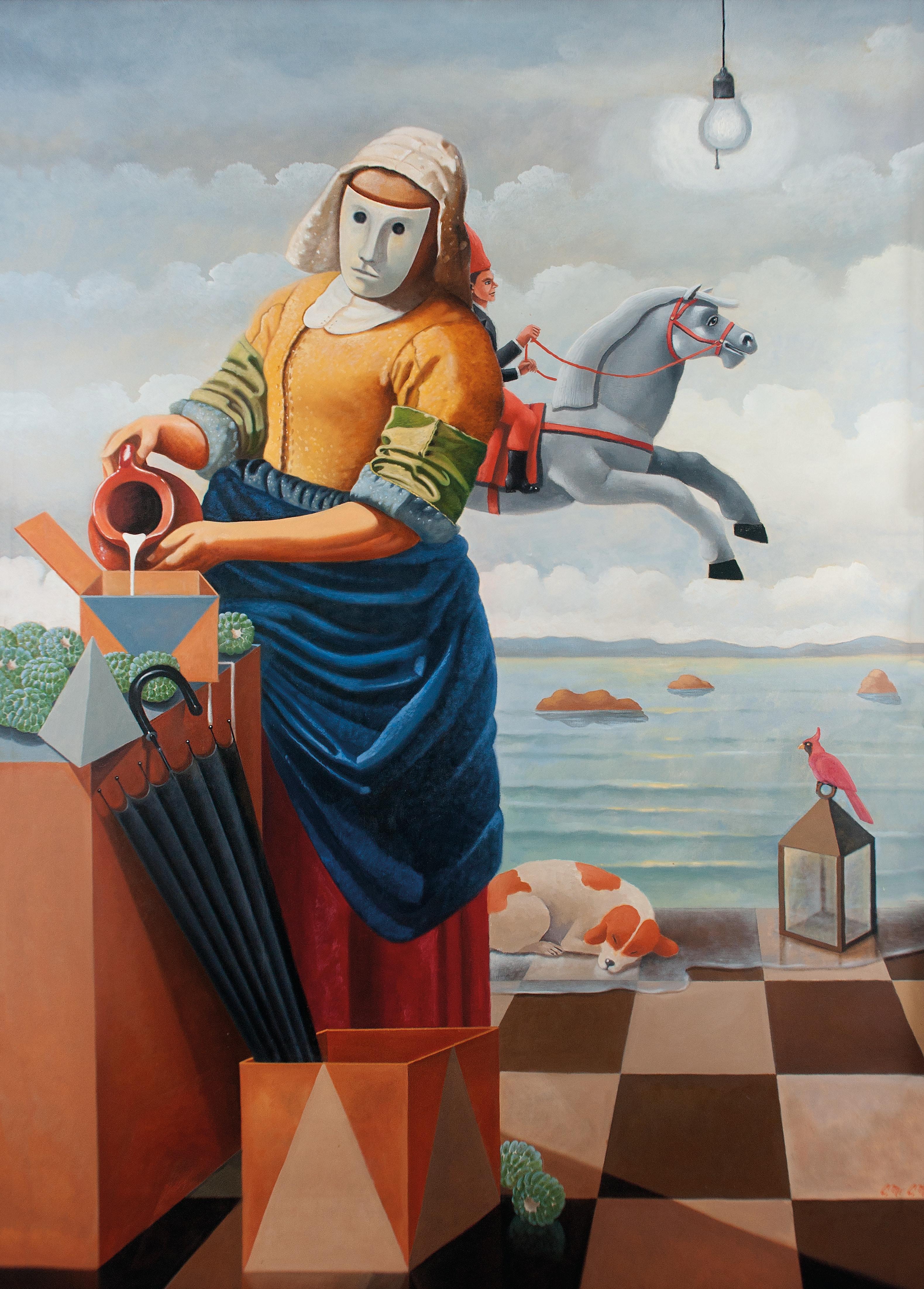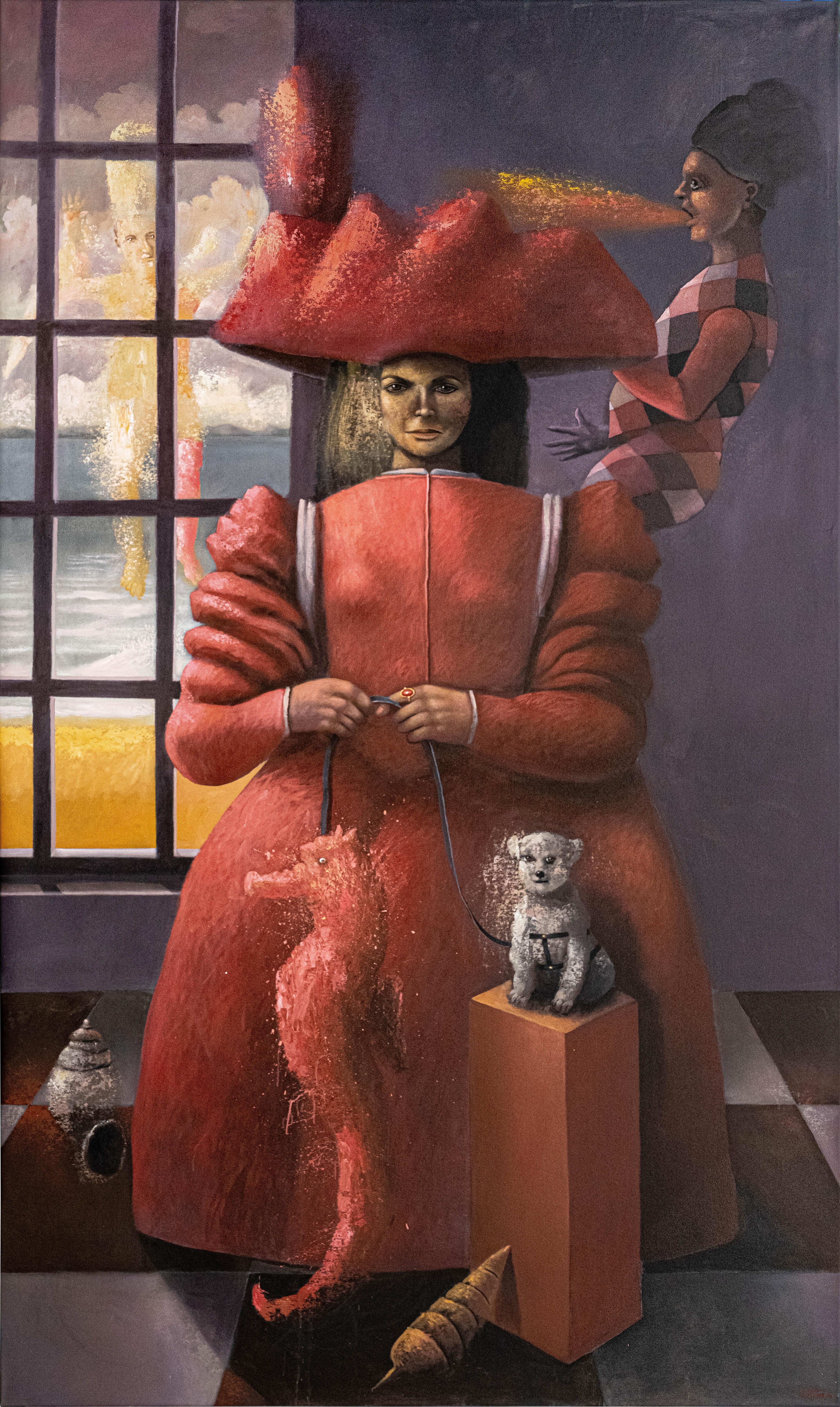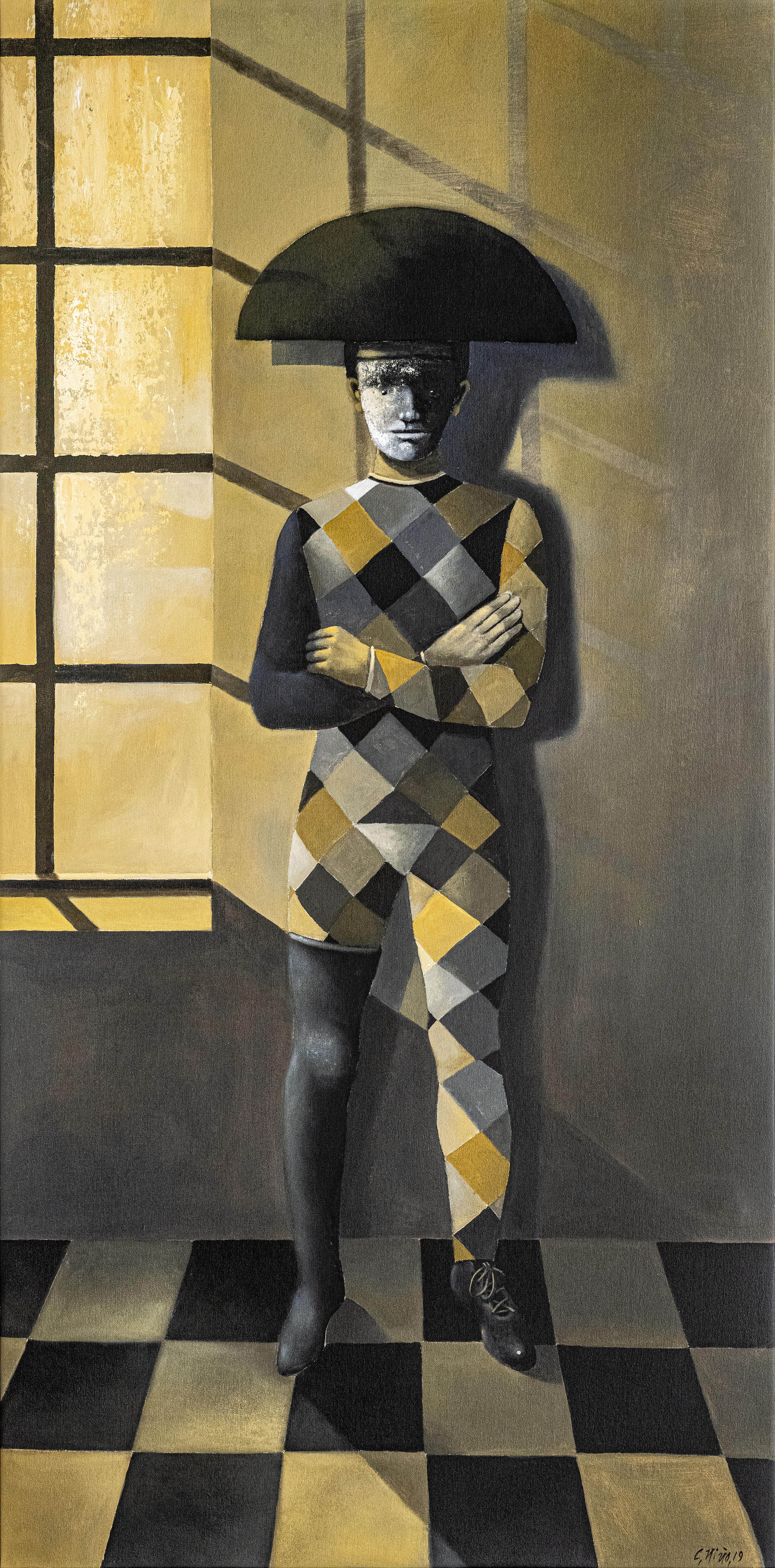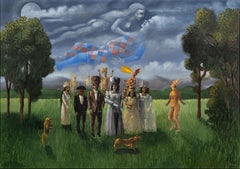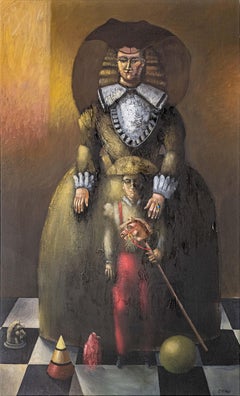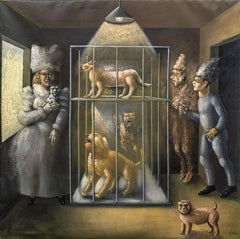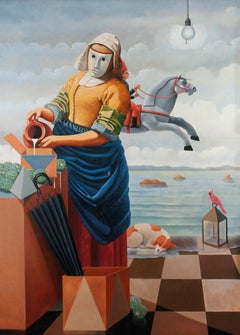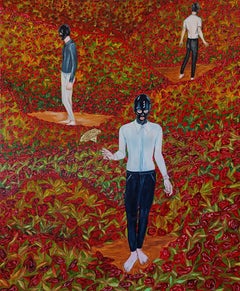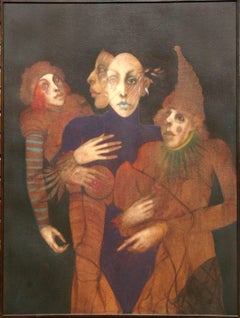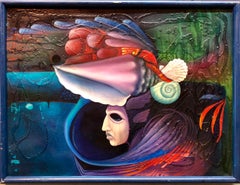Items Similar to Carmelo Niño, Amantes con escena, 2019, 200 x 400 cm, 78.7 x 157.4 in.
Want more images or videos?
Request additional images or videos from the seller
1 of 6
Carmelo NiñoCarmelo Niño, Amantes con escena, 2019, 200 x 400 cm, 78.7 x 157.4 in.2019
2019
Price Upon Request
Price Upon Request
Price Upon Request
Price Upon Request
Price Upon Request
Price Upon Request
Price Upon Request
Price Upon Request
Price Upon Request
Price Upon Request
Shipping
Retrieving quote...The 1stDibs Promise:
Authenticity Guarantee,
Money-Back Guarantee,
24-Hour Cancellation
About the Item
Carmelo Niño
Amantes con escena, 2019
Acrylic on canvas
200 x 400 cm 78.7 x 157.4 in.
The work is accompanied by a certificate of authenticity signed by the artist.
Carmelo Niño, a Venezuelan artist originally from Maracaibo, Zulia State, an oil-producing region of Venezuela, is today one of the most outstanding painters in the plastic arts landscape in the country. Many years have passed since his birth in 1951 to the present, when he inaugurates this August 2022, a major exhibition at the Ascaso Gallery in Miami, with paintings from different dates resulting from the permanent and daily work of reflection, physical and intellectual, that he has always pursued in his creative life. Without neglecting a single moment of day-to-day life to be in front of the medium-sized canvas on the easel or of larger canvas hanging on a wall, he works in his large studio in the area of El Junco, outside the capital city of Caracas, surrounded by lush green vegetation, with a wonderful climate of pleasant temperature and poetic mist that invites to the reverie and glorification of his life as a painter. From a very early age Niño and his family discovered his vocation for drawing, a discipline in which he showed a special disposition and talent. From this moment on he dedicates his life to art, to the practice of painting, starting from a fantastic and strange world of fantasy, close to surrealism, unfailingly influenced by the circus of fantasy owned by his mother and a musician father.
These circumstances will shape the artist's life. His traces and influences from the beginning will be present in his creative work, especially through the memories of the infinite curiosity to look, touch and be enraptured by the strange furniture and objects from his mother's circus that he knew were deposited in a room of the house.
This universe of fantasy will leave an indelible mark on his subconscious and will serve as the thematic and artistic support for all his work. In an interview conducted by the critic Roberto Montero Castro in 1977, Carmelo Niño states, "the symbols of my painting come from the everyday life".
His life has been one of continuous work and effort. At the age of fifteen he enrolled in the School of Arts of Maracaibo, graduated three years later, 1966, and immediately, with a scholarship, he travelled to Spain, took a few courses at the San Fernando Academy in Madrid, strengthened his preparation in art workshops and in frequent visits to the big museums of this European capital. With a sensitive gaze he penetrates the mysteries of masterpieces of the great artists who have made the universal history of art. His life as a painter has been intense, of intense study, preparation and work. With much composure and modesty he talks about his life and his artistic production, recognized not only in Venezuela, but also internationally. His participation in exhibitions began in 1969 and as early as 1970 he held his first individual exhibition at the Fine Arts Center of Maracaibo. From these dates onwards successes started to come, with the participation in collective and individual exhibitions, in Venezuela and abroad, as well as the awards from 1971, when he won the Scholarship Award at the First National Salon of Young Artists in Maracay, Aragua State; in 1972 he was awarded the Second Prize at the Regional Salon of Maracaibo. 1975 is the year of awards, he received the First Prize at the IV Salon of Young Artists in Caracas; the Aurelio Rodriguez Award at the IV Avellan Salon in Caracas and the First Prize at the Salon of Young Zulian Artists in Maracaibo; he also participated in the group exhibition of History of Painting in Venezuela, at Casa de Las Americas, Havana, Cuba; and in 1976 he was invited by Jose Gomez Sicre to take part in the exhibition of Venezuelan painting at the Museum of Latin American Art of the OAS.
But his recognition came in 1977 when he had his first solo exhibition in Caracas, at the prestigious National Art Gallery- a national museum dedicated only to Venezuelan art, where he was invited as a young talent, three distinguished critics of the country dedicated texts on the artist's work: Juan Calzadilla, Roberto Montero Castro and Sergio Antillano; and in 1981 when he received the First Prize in Painting at the First National Salon of Young Artists at the Museum of Contemporary Art in Caracas. His paintings have been shown at the Biennial of Sao Paulo, Brazil and at the Venice Biennial. And so the achievements of this artist have continued until this outstanding exhibition at the Ascaso Gallery in Miami, 2022.
Since the beginning of his career as a painter, Carmelo Niño has been a figurative artist, always obsessed with almost mythological, timeless and absent characters that he encloses in architectural modules or places them in dreamlike landscapes where they are an integral part of that landscape. Without straying from the traced route, he continues his work in the silence of his studio surrounded by canvases, brushes, paint tubes and through large windows he enjoys the beautiful Dionysian landscape that surrounds him and delights the spirit.
Bélgica Rodríguez, PhD Art critic and researcher Specialist in Latin American art
PUBLIC COLLECTION
National Art Gallery. Caracas, Venezuela.
Museum of Contemporary Art. Caracas, Venezuela. Palacio de Miraflores. Caracas, Venezuela.
Ministry of Foreign Affairs. Caracas, Venezuela. Noa Noa Foundation, Caracas, Vemezuela.
Fundación Museo Ralli, Punta del Este, Uruguay Contemporary Latin American Art, MoLAA, California, USA. Art Museum of the Americas, OAS, Washington DC, USA. Casa de las Américas, Havana, Cuba.
Government Palace, Bogotá, Colombia.
Government Palace, Santo Domingo, Dominican Republic.
Embassies of Venezuela in Brazil, USA, Mexico, France, and private collections in South America, Central America, North America, Europe and Asia.
- Creator:Carmelo Niño (1951, Venezuelan)
- Creation Year:2019
- Dimensions:Height: 78.75 in (200 cm)Width: 157.49 in (400 cm)
- Medium:
- Movement & Style:
- Period:
- Condition:
- Gallery Location:Miami, FL
- Reference Number:1stDibs: LU1613210709552
About the Seller
5.0
Vetted Professional Seller
Every seller passes strict standards for authenticity and reliability
Established in 1989
1stDibs seller since 2021
Typical response time: Several days
- ShippingRetrieving quote...Shipping from: Miami, FL
- Return Policy
Authenticity Guarantee
In the unlikely event there’s an issue with an item’s authenticity, contact us within 1 year for a full refund. DetailsMoney-Back Guarantee
If your item is not as described, is damaged in transit, or does not arrive, contact us within 7 days for a full refund. Details24-Hour Cancellation
You have a 24-hour grace period in which to reconsider your purchase, with no questions asked.Vetted Professional Sellers
Our world-class sellers must adhere to strict standards for service and quality, maintaining the integrity of our listings.Price-Match Guarantee
If you find that a seller listed the same item for a lower price elsewhere, we’ll match it.Trusted Global Delivery
Our best-in-class carrier network provides specialized shipping options worldwide, including custom delivery.More From This Seller
View AllCarmelo Niño, Amantes con escena, 2019, 140 x 200 cm, 55.1 x 78.7 in.
By Carmelo Niño
Located in Miami, FL
Carmelo Niño
Amantes con escena, 2019
Acrylic on canvas
140 x 200 cm 55.1 x 78.7 in.
The work is accompanied by a certificate of authenticity signed by ...
Category
2010s Surrealist Figurative Paintings
Materials
Canvas, Acrylic
Carmelo Niño, El Primogénito, 2021, 200 x 120 cm, 78.7 x 47.2 in.
By Carmelo Niño
Located in Miami, FL
Carmelo Niño
El Primogénito, 2021
Acrylic on canvas
200 x 120 cm 78.7 x 47.2 in.
The work is accompanied by a certificate of authenticity signed by the ...
Category
2010s Surrealist Figurative Paintings
Materials
Canvas, Acrylic
Carmelo Niño, La Jaula, 2018, 200 x 200 cm, 78.7 x 78.7 in.
By Carmelo Niño
Located in Miami, FL
Carmelo Niño
La Jaula, 2018
Acrylic on canvas
200 x 200 cm 78.7 x 78.7 in.
The work is accompanied by a certificate of authenticity signed by the artist...
Category
2010s Surrealist Figurative Paintings
Materials
Canvas, Acrylic
Carmelo Niño, Lechera, 2014, Oil on canvas, 207 x 149 cm, 81.4 x 58.6 in.
By Carmelo Niño
Located in Miami, FL
Carmelo Niño
Lechera, 2014
Oil on canvas
207 x 149 cm
81.4 x 58.6 in.
The work is accompanied by a certificate of authenticity signed by the artist.
Carmelo Niño, a Venezuelan artist originally from Maracaibo, Zulia State, an oil-producing region of Venezuela, is today one of the most outstanding painters in the plastic arts landscape in the country. Many years have passed since his birth in 1951 to the present, when he inaugurates this August 2022, a major exhibition at the Ascaso Gallery in Miami, with paintings from different dates resulting from the permanent and daily work of reflection, physical and intellectual, that he has always pursued in his creative life. Without neglecting a single moment of day-to-day life to be in front of the medium-sized canvas on the easel or of larger canvas hanging on a wall, he works in his large studio in the area of El Junco, outside the capital city of Caracas, surrounded by lush green vegetation, with a wonderful climate of pleasant temperature and poetic mist that invites to the reverie and glorification of his life as a painter. From a very early age Niño and his family discovered his vocation for drawing, a discipline in which he showed a special disposition and talent. From this moment on he dedicates his life to art, to the practice of painting, starting from a fantastic and strange world of fantasy, close to surrealism, unfailingly influenced by the circus of fantasy owned by his mother and a musician father.
These circumstances will shape the artist's life. His traces and influences from the beginning will be present in his creative work, especially through the memories of the infinite curiosity to look, touch and be enraptured by the strange furniture and objects from his mother's circus that he knew were deposited in a room of the house.
This universe of fantasy will leave an indelible mark on his subconscious and will serve as the thematic and artistic support for all his work. In an interview conducted by the critic Roberto Montero Castro in 1977, Carmelo Niño states, "the symbols of my painting come from the everyday life".
His life has been one of continuous work and effort. At the age of fifteen he enrolled in the School of Arts of Maracaibo, graduated three years later, 1966, and immediately, with a scholarship, he travelled to Spain, took a few courses at the San Fernando Academy in Madrid, strengthened his preparation in art workshops and in frequent visits to the big museums of this European capital. With a sensitive gaze he penetrates the mysteries of masterpieces of the great artists who have made the universal history of art. His life as a painter has been intense, of intense study, preparation and work. With much composure and modesty he talks about his life and his artistic production, recognized not only in Venezuela, but also internationally. His participation in exhibitions began in 1969 and as early as 1970 he held his first individual exhibition at the Fine Arts Center of Maracaibo. From these dates onwards successes started to come, with the participation in collective and individual exhibitions, in Venezuela and abroad, as well as the awards from 1971, when he won the Scholarship Award at the First National Salon of Young Artists in Maracay, Aragua State; in 1972 he was awarded the Second Prize at the Regional Salon of Maracaibo. 1975 is the year of awards, he received the First Prize at the IV Salon of Young Artists in Caracas; the Aurelio Rodriguez Award at the IV Avellan Salon in Caracas and the First Prize at the Salon of Young Zulian Artists in Maracaibo; he also participated in the group exhibition of History of Painting in Venezuela, at Casa de Las Americas, Havana, Cuba; and in 1976 he was invited by Jose Gomez Sicre to take part in the exhibition of Venezuelan painting...
Category
2010s Surrealist Figurative Paintings
Materials
Canvas, Oil
Carmelo Niño, Carolina niña con Marina, 2021, 350 x 200 cm, 137.7 x 78.7 in.
By Carmelo Niño
Located in Miami, FL
Carmelo Niño
Carolina niña con Marina, 2021
Acrylic on canvas
350 x 200 cm 137.7 x 78.7 in.
The work is accompanied by a certificate of authenticity signed by the artist.
Carmelo Niño, a Venezuelan artist originally from Maracaibo, Zulia State, an oil-producing region of Venezuela, is today one of the most outstanding painters in the plastic arts landscape in the country. Many years have passed since his birth in 1951 to the present, when he inaugurates this August 2022, a major exhibition at the Ascaso Gallery in Miami, with paintings from different dates resulting from the permanent and daily work of reflection, physical and intellectual, that he has always pursued in his creative life. Without neglecting a single moment of day-to-day life to be in front of the medium-sized canvas on the easel or of larger canvas hanging on a wall, he works in his large studio in the area of El Junco, outside the capital city of Caracas, surrounded by lush green vegetation, with a wonderful climate of pleasant temperature and poetic mist that invites to the reverie and glorification of his life as a painter. From a very early age Niño and his family discovered his vocation for drawing, a discipline in which he showed a special disposition and talent. From this moment on he dedicates his life to art, to the practice of painting, starting from a fantastic and strange world of fantasy, close to surrealism, unfailingly influenced by the circus of fantasy owned by his mother and a musician father.
These circumstances will shape the artist's life. His traces and influences from the beginning will be present in his creative work, especially through the memories of the infinite curiosity to look, touch and be enraptured by the strange furniture and objects from his mother's circus that he knew were deposited in a room of the house.
This universe of fantasy will leave an indelible mark on his subconscious and will serve as the thematic and artistic support for all his work. In an interview conducted by the critic Roberto Montero Castro in 1977, Carmelo Niño states, "the symbols of my painting come from the everyday life".
His life has been one of continuous work and effort. At the age of fifteen he enrolled in the School of Arts of Maracaibo, graduated three years later, 1966, and immediately, with a scholarship, he travelled to Spain, took a few courses at the San Fernando Academy in Madrid, strengthened his preparation in art workshops and in frequent visits to the big museums of this European capital. With a sensitive gaze he penetrates the mysteries of masterpieces of the great artists who have made the universal history of art. His life as a painter has been intense, of intense study, preparation and work. With much composure and modesty he talks about his life and his artistic production, recognized not only in Venezuela, but also internationally. His participation in exhibitions began in 1969 and as early as 1970 he held his first individual exhibition at the Fine Arts Center of Maracaibo. From these dates onwards successes started to come, with the participation in collective and individual exhibitions, in Venezuela and abroad, as well as the awards from 1971, when he won the Scholarship Award at the First National Salon of Young Artists in Maracay, Aragua State; in 1972 he was awarded the Second Prize at the Regional Salon of Maracaibo. 1975 is the year of awards, he received the First Prize at the IV Salon of Young Artists in Caracas; the Aurelio Rodriguez Award at the IV Avellan Salon in Caracas and the First Prize at the Salon of Young Zulian Artists in Maracaibo; he also participated in the group exhibition of History of Painting in Venezuela, at Casa de Las Americas, Havana, Cuba; and in 1976 he was invited by Jose Gomez Sicre to take part in the exhibition of Venezuelan painting...
Category
2010s Surrealist Figurative Paintings
Materials
Canvas, Acrylic
Carmelo Niño, Gran arlequín, 2019, 200 x 100 cm, 78.7 x 39.3 in.
By Carmelo Niño
Located in Miami, FL
Carmelo Niño
Gran arlequín, 2019
Acrylic on canvas
200 x 100 cm
78.7 x 39.3 in.
The work is accompanied by a certificate of authenticity signed by the ar...
Category
2010s Surrealist Figurative Paintings
Materials
Canvas, Acrylic
You May Also Like
surreal scene oil on canvas painting surrealism
Located in Barcelona, Barcelona
Francesc Gironés (1904-1997) - Surrealist scene - Oil canvas
Oil measures 38x46 cm.
Frame measures 47x55 cm.
Francesc Gironés was a painter from Poblenou about whom little is known,...
Category
1980s Surrealist Figurative Paintings
Materials
Canvas, Oil
The desire to take refuge in oblivion and frivolity arises, Figurative Painting
Located in Miami Beach, FL
Ramonn Vieitez is a self-taught Brazilian artist who primarily utilizes painting as a field of creative possibility exploring themes such as identity, memory, and nature, compulsivel...
Category
2010s Contemporary Figurative Paintings
Materials
Canvas, Oil, Acrylic
Multi-Facet, Large Surrealist Oil Painting by Ramon Santiago
By Ramon Santiago
Located in Long Island City, NY
Artist: Ramon Santiago, American (1943 - 2001)
Title: Multi-Facet
Year: 1974
Medium: Oil on Canvas, signed and dated
Size: 40 x 34 inches
Category
1970s Surrealist Figurative Paintings
Materials
Canvas, Oil
Magic Realist Surrealist Latin American Naive Fantasy Painting
By German Ramon Duron Lanza
Located in Surfside, FL
Magic realist fantasy painting in the manner of Ernst Fuchs and Arik Brauer.
Naïve art is any form of visual art that is created by a person who lacks the formal education and training that a professional artist undergoes (in anatomy, art history, technique, perspective, ways of seeing). Unlike folk art, naïve art does not necessarily evince a distinct cultural context or tradition. Naïve art is recognized, and often imitated, for its childlike simplicity and frankness. Paintings of this kind typically have a flat rendering style with a rudimentary expression of perspective.
One particularly influential painter of "naïve art" was Henri Rousseau (1844–1910), a French Post-Impressionist who was discovered by Pablo Picasso.
Naïve art is often seen as outsider art that is by someone without formal (or little) training or degree. While this was true before the twentieth century, there are now academies for naïve art. Naïve art is now a fully recognized art genre, represented in art galleries worldwide.
Museums devoted to naïve art now exist in Kecskemét, Hungary; Riga, Latvia; Jaen, Spain; Rio de Janeiro, Brasil; Vicq France and Paris. "Primitive art" is another term often applied to art by those without formal training, but is historically more often applied to work from certain cultures that have been judged socially or technologically "primitive" by Western academia, such as Native American, sub saharan African or Pacific Island art (see Tribal art). This is distinguished from the self-conscious, "primitive" inspired movement primitivism. Another term related to (but not completely synonymous with) naïve art is folk art.
There also exist the terms "naïvism" and "primitivism" which are usually applied to professional painters working in the style of naïve art (like Paul Gauguin, Mikhail Larionov, Paul Klee).
At all events, naive art can be regarded as having occupied an "official" position in the annals of twentieth-century art since - at the very latest - the publication of the Der Blaue Reiter, an almanac in 1912. Wassily Kandinsky and Franz Marc, who brought out the almanac, presented 6 reproductions of paintings by le Douanier' Rousseau (Henri Rousseau), comparing them with other pictorial examples. However, most experts agree that the year that naive art was "discovered" was 1885, when the painter Paul Signac became aware of the talents of Henri Rousseau and set about organizing exhibitions of his work in a number of prestigious galleries.
The Earth Group (Grupa Zemlja) were Croatian artists, architects and intellectuals active in Zagreb from 1929 to 1935. The group included the painters Krsto Hegedušić, Edo Kovačević, Omer Mujadžić, Kamilo Ružička, Ivan Tabaković, and Oton Postružnik, the sculptors Antun Augustinčić, Frano Kršinić, and the architect Drago Ibler.
A term applied to Yugoslav (Croatian) naive painters working in or around the village of Hlebine, near the Hungarian border, from about 1930. Some of the best known naive artists are Dragan Gaži, Ivan Generalić, Josip Generalić, Krsto Hegedušić, Mijo Kovačić, Ivan Lacković-Croata, Franjo Mraz, Ivan Večenaj and Mirko Virius.
Camille Bombois (1883–1970) Ferdinand Cheval, known as 'le facteur Cheval' (1836–1924)
Henry Darger (1892–1973) L. S. Lowry (1887–1976) Grandma Moses, Anna Mary Robertson (1860–1961) Nikifor (1895–1968) Poland, Horace Pippin (1888–1946) Jon Serl (1894-1993) United States
Alfred Wallis (1855–1942) Scottie Wilson (1890–1972) Gesner Abelard (b. 1922) Jan Balet (1913–2009) Michel Delacroix (b. 1933) France Howard Finster (1916–2001) Ivan Rabuzin (1921–2008)
Spontaneous Art Museum in Brussels
Art en Marge Museum in Brussels
MADmusée in Liege
International Museum of Naive Art of Brazil in Cosme Velho, Rio de Janeiro
Gallery Jacques Ardies in São Paulo
Musée international d'art naïf de Magog in Magog
Croatian Museum of Naïve Art in Zagreb
Gallery of Croatian Naïve Art...
Category
20th Century Folk Art Figurative Paintings
Materials
Canvas, Acrylic
La Balade De Juanito Cana Hueca Cuban Surrealist
Located in Lake Worth Beach, FL
La Balade De Juanito Cana Hueca 2019
Acrylic and ink on canvas signed and dated, it will be frame before shipping.
Isaac Crespo's Cuban artist born 1965. His drawings and paintings s...
Category
2010s Surrealist Figurative Paintings
Materials
Canvas, Ink, Acrylic
"Dream of Spring" 2016 painting oil and acrylic on canvas 48x72 in
By Luis Miguel Valdes
Located in Miami, FL
Luis Miguel Valdes (Cuban, 1949)
"Dream of Spring", 2016
Oil and acrylic on canvas
48 × 72 in (121.9 × 182.9 cm)
Luis Miguel Valdés, Biography
Luis Miguel Valdés, a renowned Cuban ...
Category
2010s Contemporary Figurative Paintings
Materials
Oil, Acrylic, Canvas
More Ways To Browse
Cuban Surrealist Paintings
Mexican Santos Painting
Roberto Santo
Santo Nino
Carmelo Nino
Oil Painting Sisters
Swimming Painting
Vienna Oil Painting
Flemish Frame
Male Figure Painting
Peace Symbol Art
Framed Art Set Of 6
Jean English
Mystery Set
Oil Paintings Dutch Master
Paul Bright
Queen Elizabeth
Oil Painting Cafe
